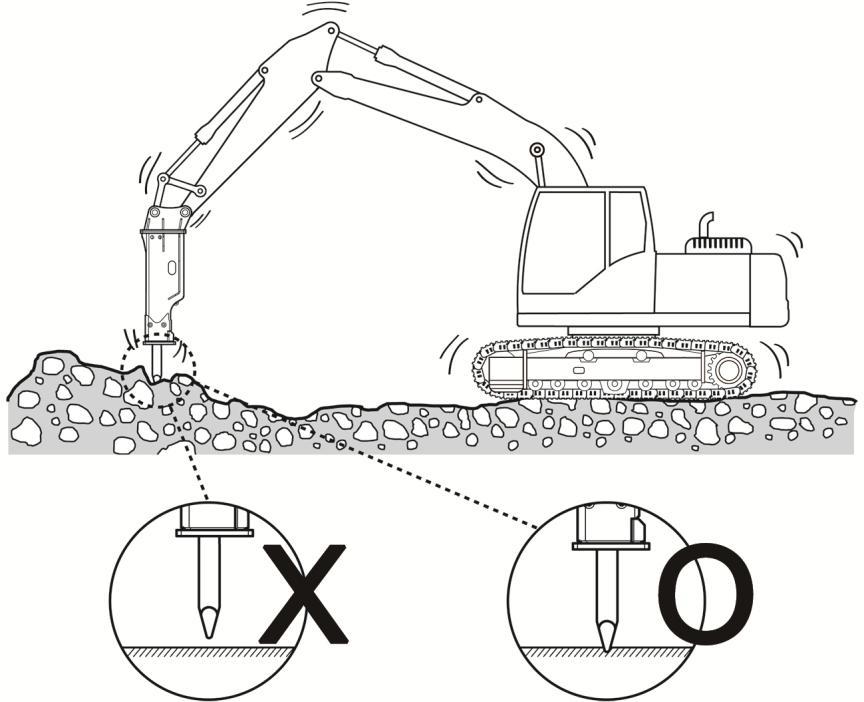
11 minute read
I. Operating
When operating, the operator should pay attention to the following points.
First of all, precautionary measures should be taken to rule out the risks of accident.
• Operate the breaker only from the cabin inside the carrier. • Close the cabin front screen or splinter guard to avoid injury from flying rock splinters. • Wear ear protection to prevent hearing ability impairment. Anyone in the immediate vicinity of breaker operations should also wear ear protection. • Switch breaker off immediately if any one moves into the risk zone.
a) Proper way of operation Proper thrust
To break effectively, a proper thrust force has to be applied to the breaker. If a thrust is insufficient, breaker impact energy may not be sufficient enough for breaking material. Then the breaking force may be transferred to breaker body, arm and boom of the carrier, etc. and cause damage to those parts.
On the contrary, if a thrust is excessive or if breaking is performed with carrier’s tracks completely lifted, the carrier may suddenly tilt toward the movement. When the material is broken, the breaker body may violently hit against material and cause damage on the breaker.
If breaker operation is carried out under such a condition, vibrations may also be transferred to the carrier. Therefore breaking in such a manner should be avoided for protection of the carrier as well. Therefore during breaking, always ensure to apply a proper level of thrust to the breaker. Do not break without properly applied thrust.
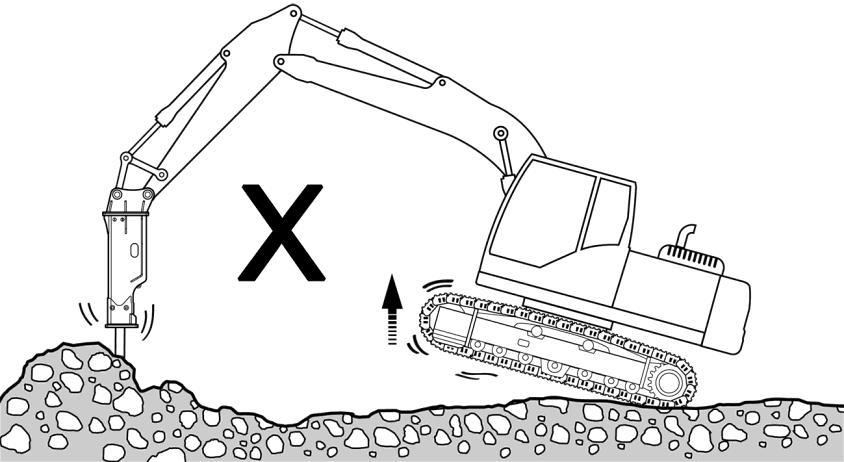
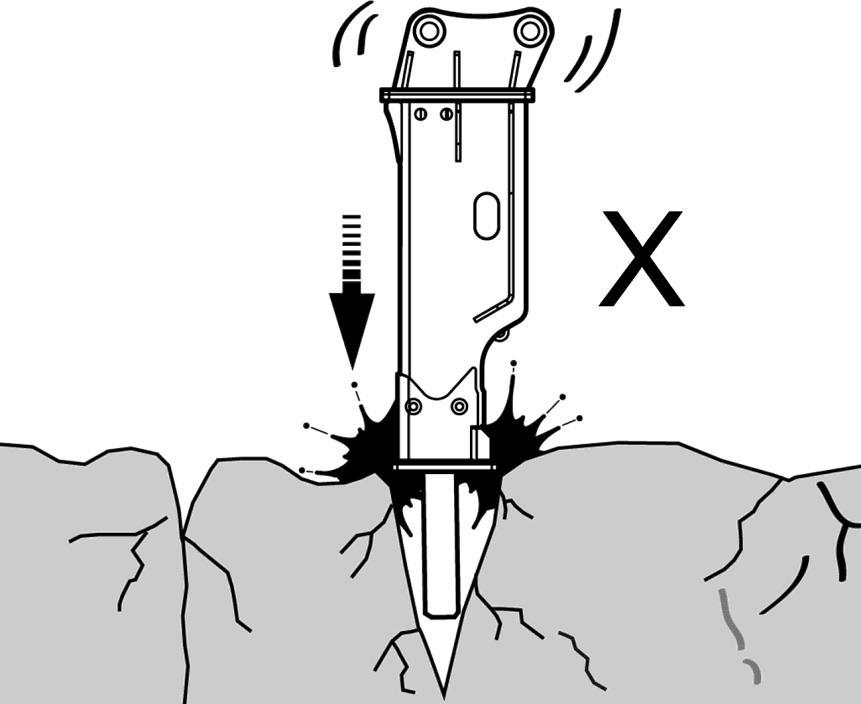
Direction of thrust
Apply thrust in a straight line with the tool. Place the tool on the material with a position as vertical as possible. If the breaker stands on the material with an oblique position, the tool may slip over the material and cause tool and/or piston crack or seizing. When breaking, select a point of the material where the breaker can be operated with the tool stably staying on the material.
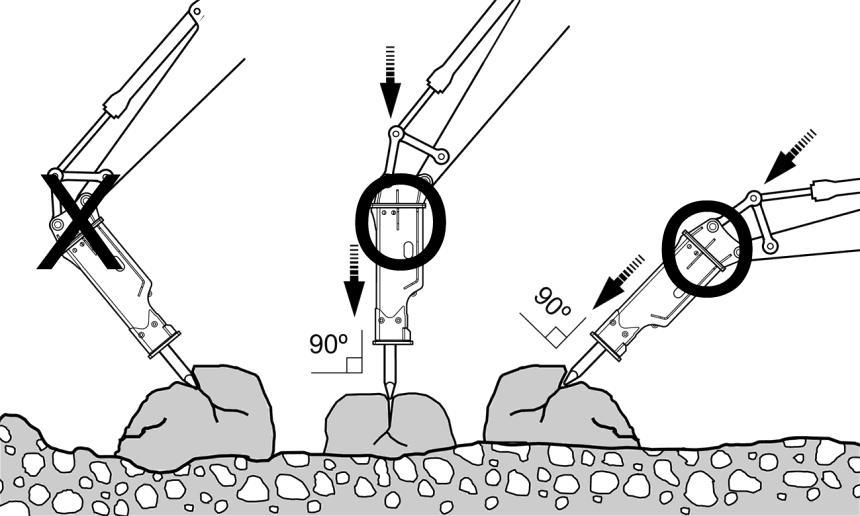
b) Stop breaker operation as soon as the hoses vibrate excessively
Check if high and low pressure hoses vibrate excessively. If that, accumulator may not be working properly. Contact your authorized dealer and get it repaired. Check hose fitting points. If oil leaks, retighten or if necessary replace them. Check if tool is moving up and down during operation as illustrated below. If not, tool may be seized. Disassemble front head and repair or if necessary replace defective parts.
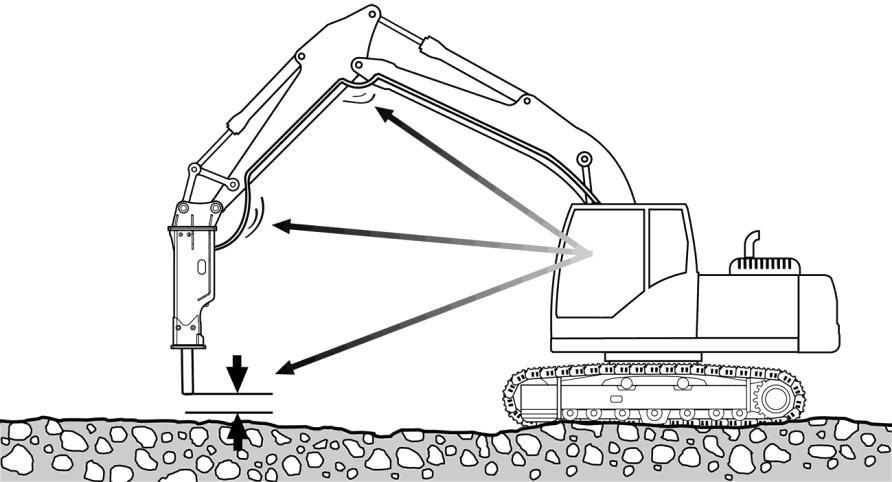
c) Stop when the material is broken (avoid idle breaking to the utmost)
As soon as material is broken, stop breaking and prevent idle breaking. If idle breaking continues, it can cause accumulator damage and bolt loosening or crack. It also can affect the carrier adversely. When a proper thrust is not applied or the tool is used like a lever during the operation, idle breaking will occur. In idle breaking, breaker striking generates abnormal sound like metal to metal hitting.
d) Never use to move the material
As shown on below picture, do not roll or throw in and out any material with tool or housing. It can cause damage such as crack, deformation, abnormal wearing, etc. on bolt, housing and tool crack (or scuffed). It can also damage carrier boom & arm. Never move the material with breaker. Particularly never let the carrier travel with tool inside the material.
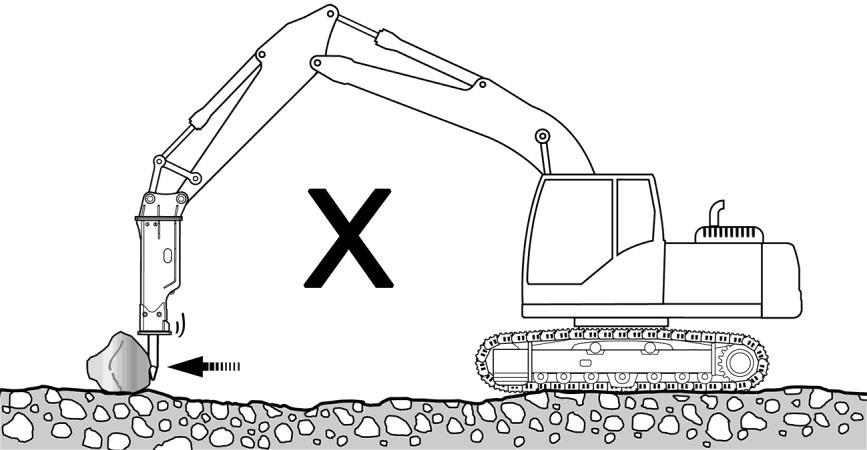
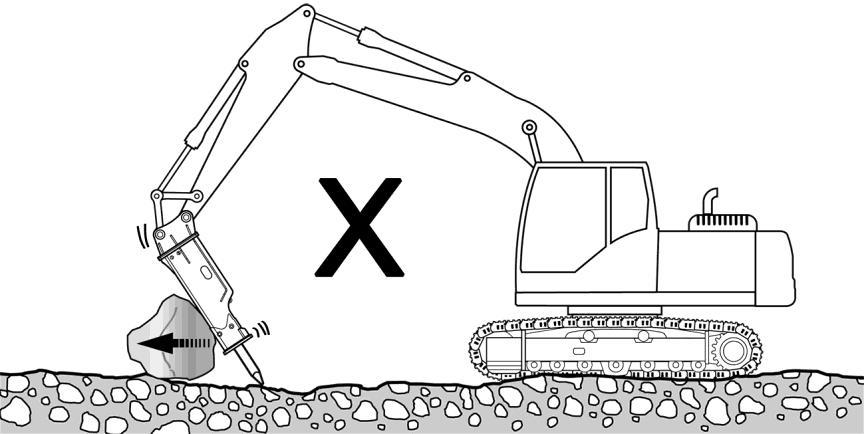
e) Never lever with the breaker
Never attempt to use the breaker like a crowbar. It will cause tool crack.
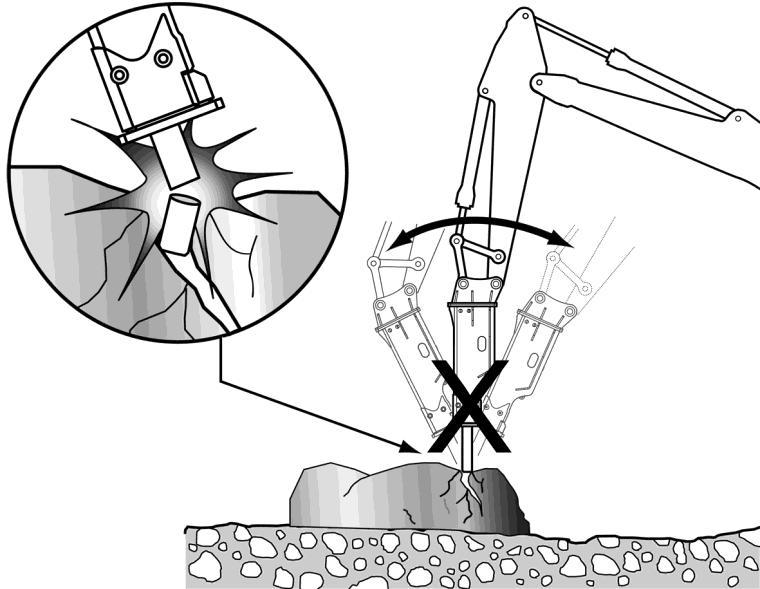
f) No breaking longer than 15 seconds continuously
When rocks are hardened, each breaking requires a longer time. However do not break a same spot for longer than 30 seconds. Change the breaking spot. If not, oil temperature can increase, causing accumulator damage and excessive tool wearing.
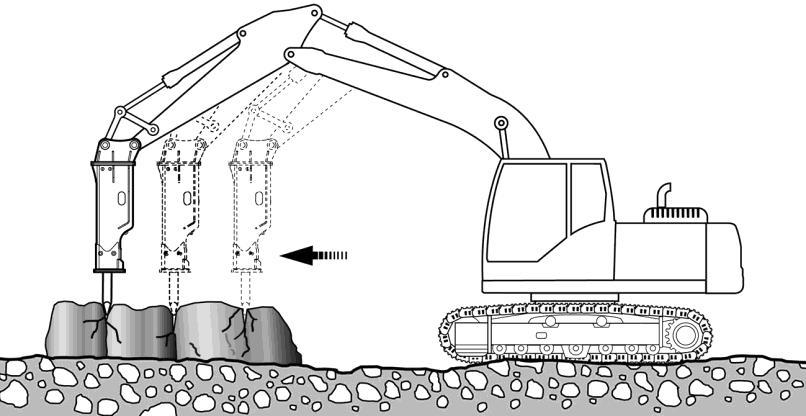
g) Start at an edge in case of hard and large size rock
Start of breaking at a crack or edge area will enable hard and large size rock to be easily broken. Advancing by small step is more effective than large step.
h) Use of proper engine speed
Breaker works at the specified engine speed. Raising engine speed to the highest rpm levels does not increase breaking force but raises oil temperature that can cause breaker internal component failures. To run the breaker at proper engine speed, please refer to carrier Operator’s Manual.
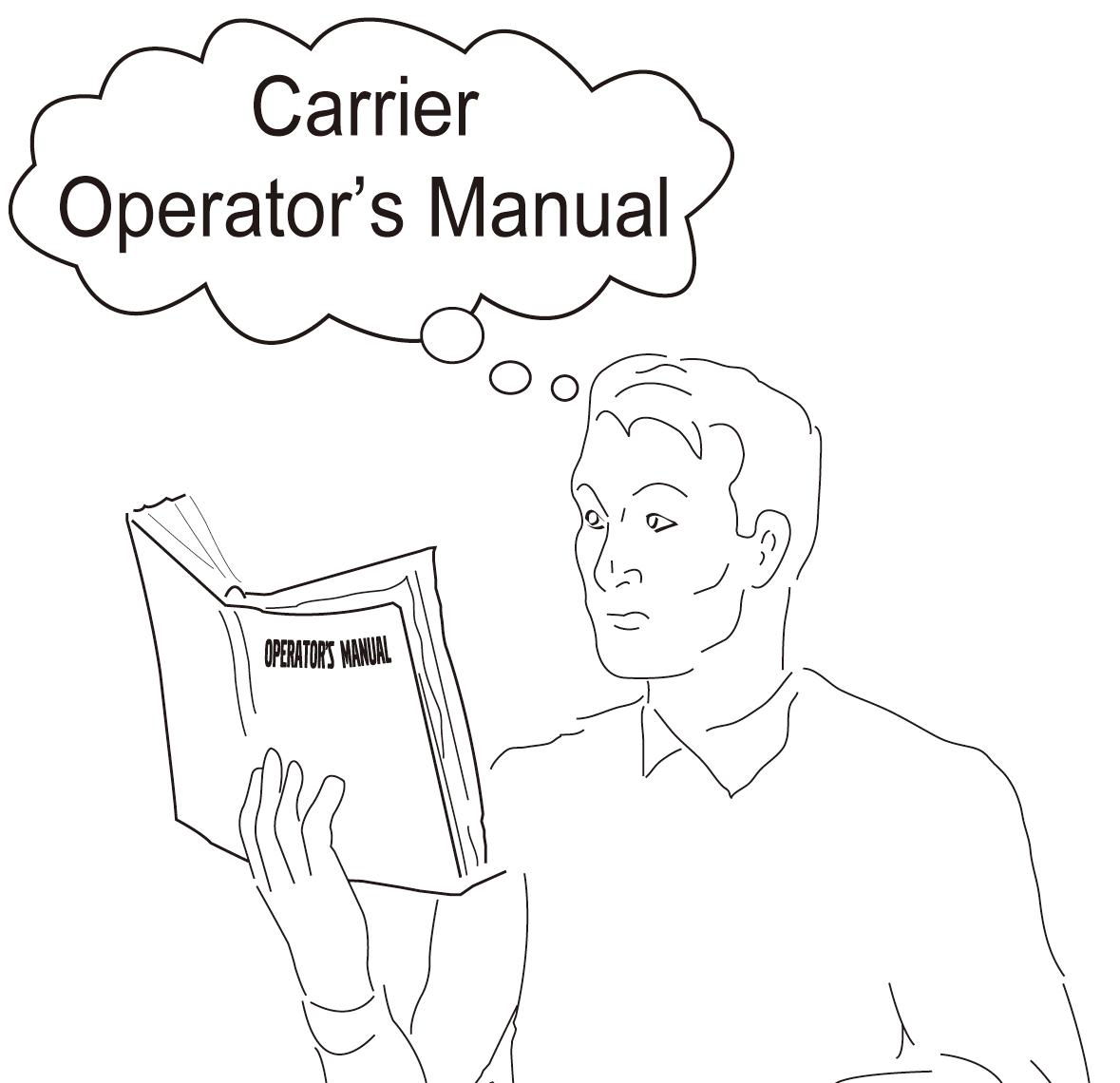
i) Never use at underwater or muddy applications without prior conversion
If water enter the percussion chamber, breaker blows may generate pressure waves that may cause irreparable damage to cylinder, piston and front head of the breaker. In addition lower percussion piston zone may get rust. Water could also get into carrier hydraulic system. In order to avoid damage to the breaker, contact your authorized dealer and use a kit dedicated for underwater application.
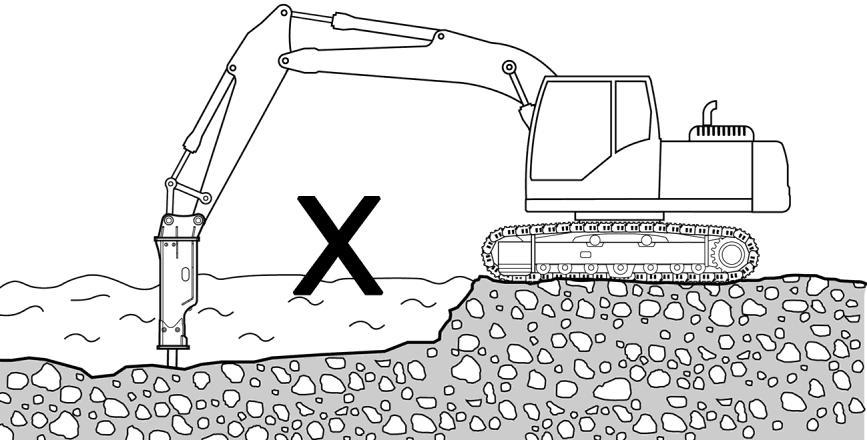
j) Never use breaker like a sledge
Before starting up, rest the breaker on the ground. Never attempt to use the breaker and the carrier boom like a sledge when breaking the material. It will damage parts of the carrier.
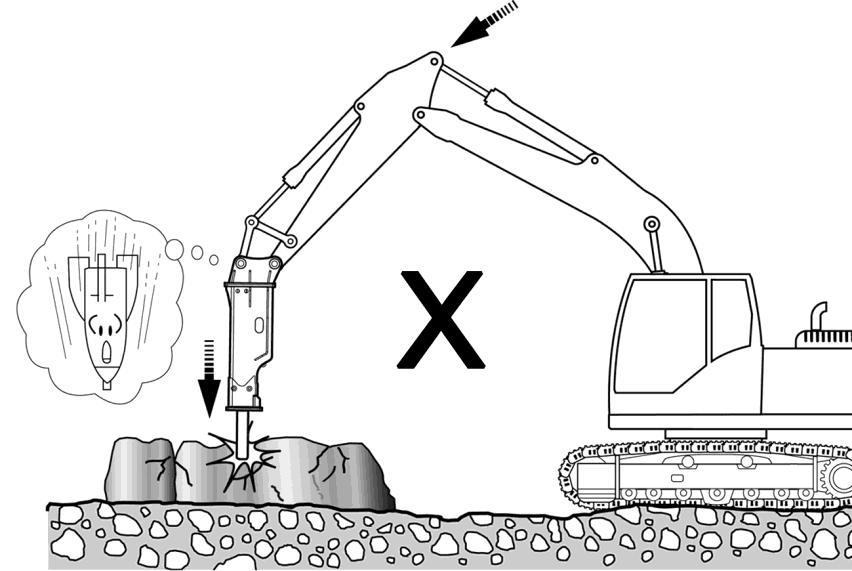
k) Never break with the cylinders at fully extended position
The carrier cylinders may be easily damaged when the breaker works with their fully stretched position to the end.
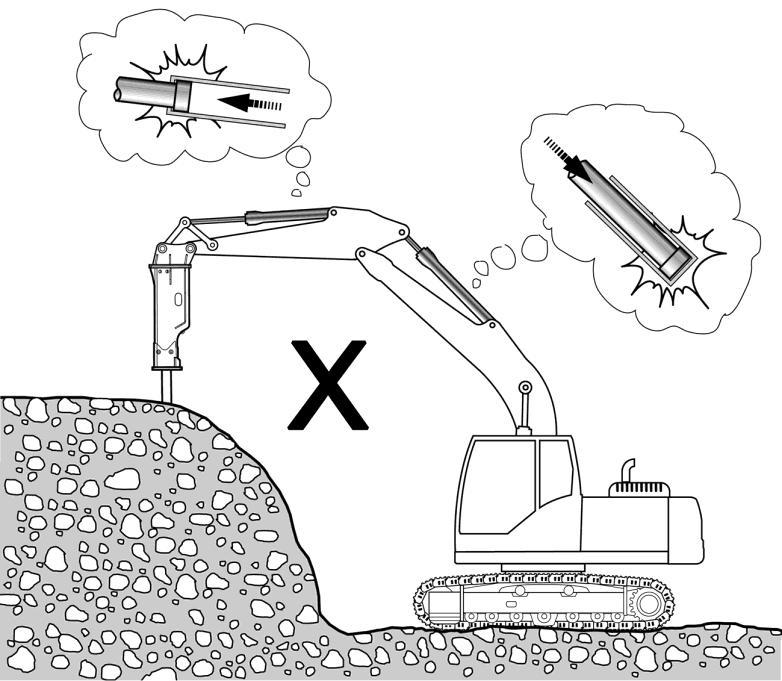
l) Never use for transport or lifting purpose
The breaker is not designed for lifting or transporting work. It can be easily damaged if used for lifting or transporting material purpose. Furthermore it is very dangerous, incurring serious accidents.
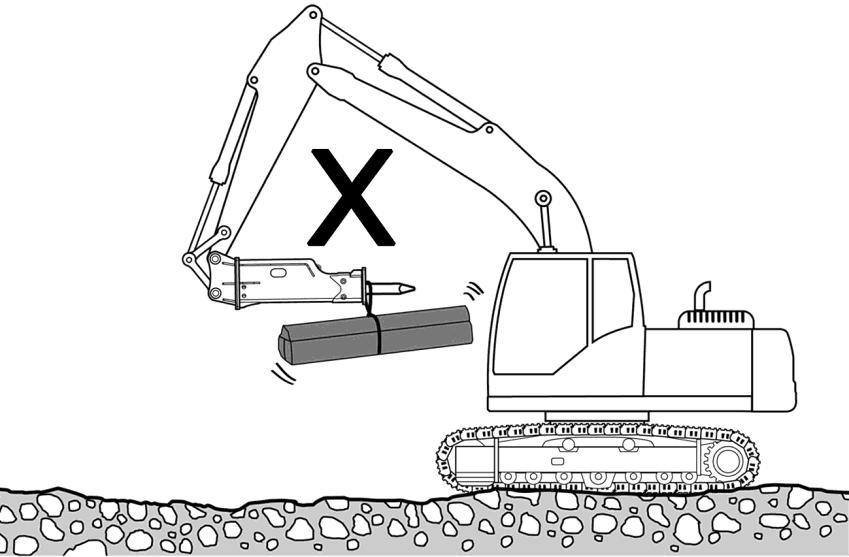
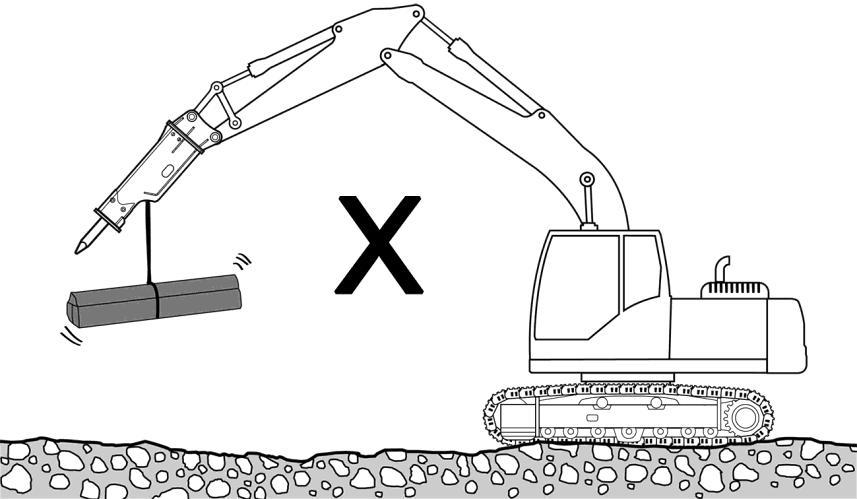
m) How to operate breaker in secondary rock breaking applications
Tool pins can be easily cracked or damaged in secondary rock breaking quarry applications. Typical root cause is that tool hits tool pin repeatedly during the breaker operation. Follow below instruction for correct breaker operation.
Regulate operating pedal or switch to limit number of blows per breaking. This is important!
Rock 30cm Rock 50cm Rock 100cm 1 blow 2 blows 3~5 blows
In case the rock is unstable or slippery, blank firing can occur (tool hits tool pin with high impact power when the breaker slips down off the rock). Ensure that you avoid blank firing by proper positioning of the breaker.
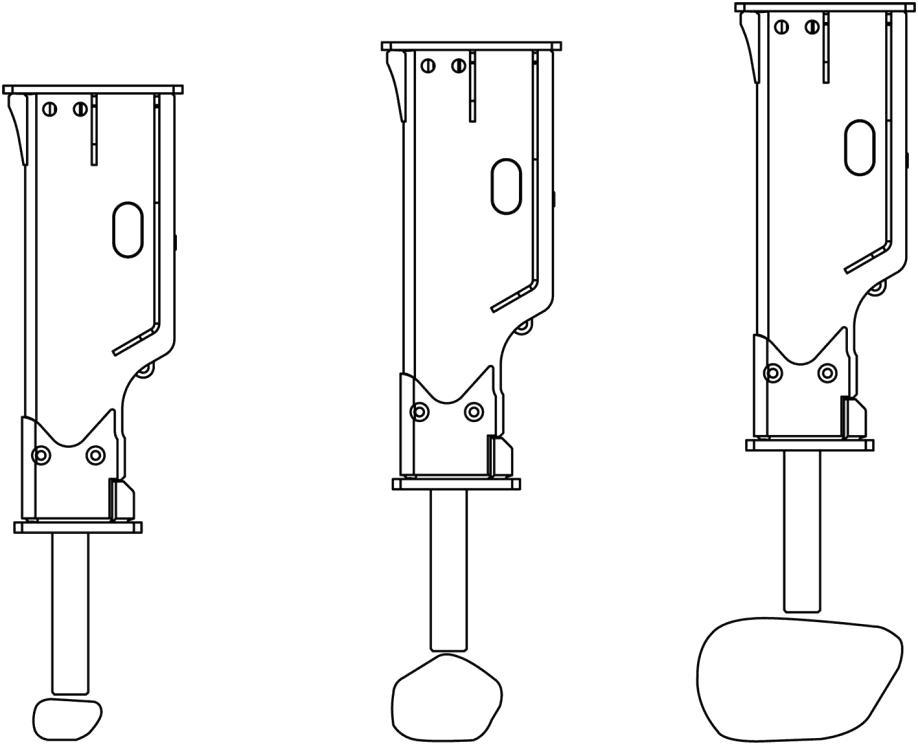
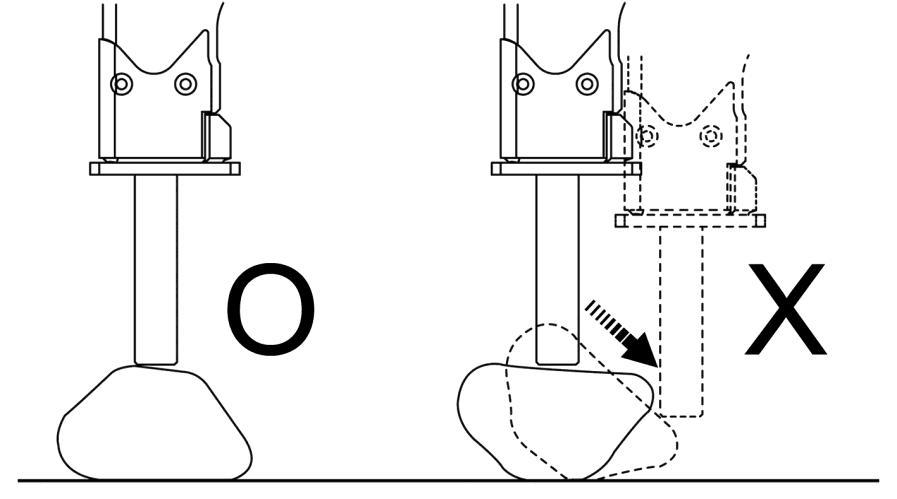
Use blunt (flat end point) tool.
<Blunt> <Moil> <Chisel>
Do not lift up carrier tracks.
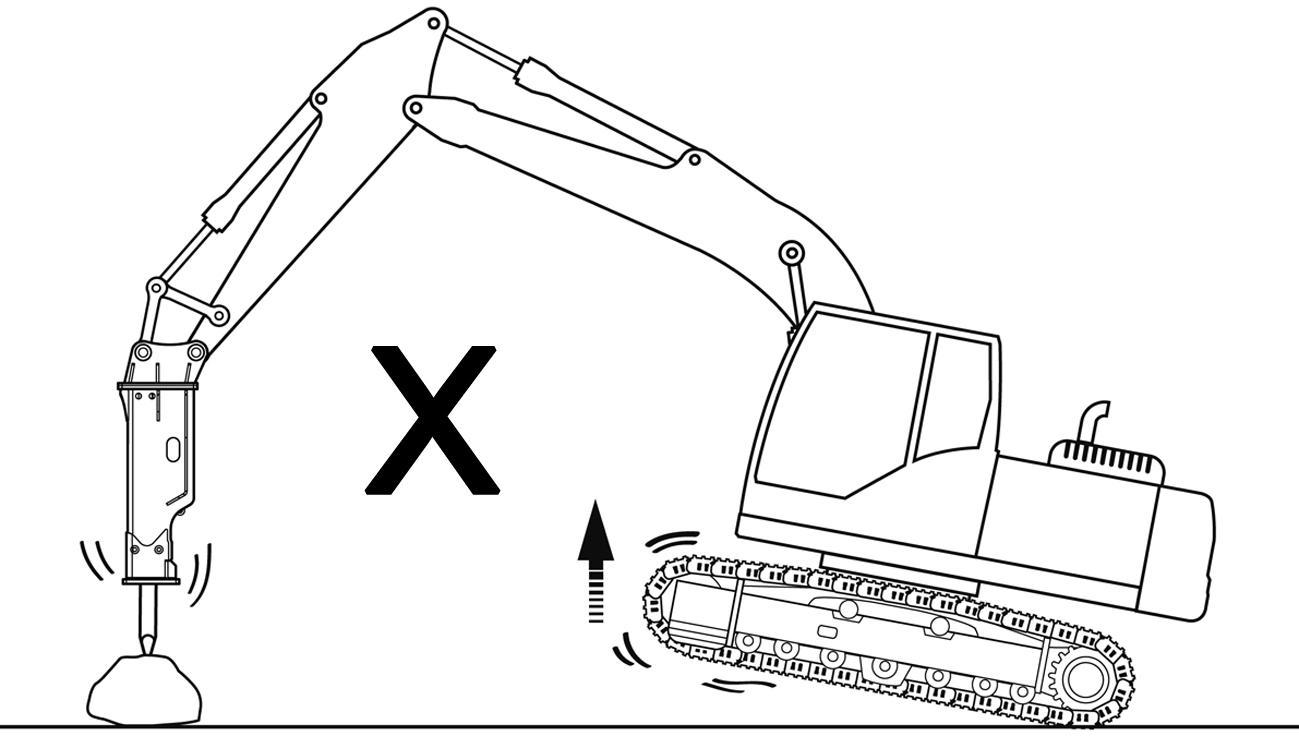
Slow down breaker BPM (striking frequency) to 70% of conventional application BPM.
In case you follow the aforesaid instruction, you will achieve a longer tool pin life as the risks of tool pin crack and excessive wearing can be reduced drastically. It will also increase housing service life by slowing down housing bottom area wearing.
However 5~10 blows per breaking may also be required when breaking large size rock boulders (larger than 1 meter).
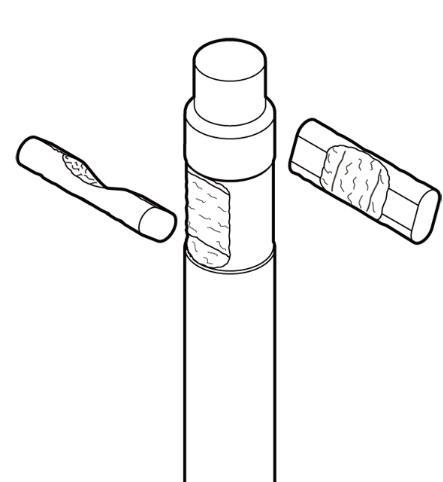
Note!
Lack of respect to the aforesaid instructions can cause failure to tool pin and also consequential failure to front head at relatively early hours, which will not be supported by manufacturer’s warranty.
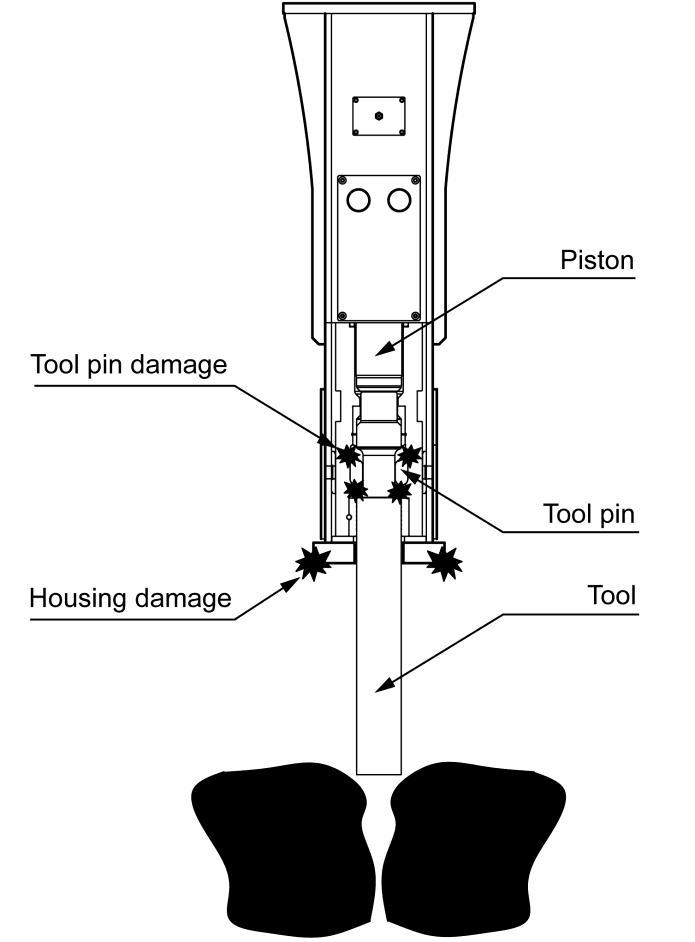
n) Anti blank firing (Auto-Stop)
Blank firing occurs when the operator keeps pressing breaker pedal switch even after breaking material is completely broken. Then 3~5 times of surplus hitting by accumulated oil flow is conveyed directly to through bolts, tool pin and other parts where damage can occur.
Anti blank firing system was designed to stop breaker operation after only one extra blow if the material is fully broken, has proved its efficiency as well as durability and liability in actual operations at the job sites.
However in case of secondary rock breaking application where the material sizes are small, the materials are broken by 1~2 blows and then the breaker fires blanks. Therefore operator has to be extremely careful and follow below instructions to prevent premature and unnecessary tool failure. • Use blunt tool • Operator must stop striking immediately after the material is broken.
o) Working in high temperature conditions
Hydraulic oil temperature must not exceed 80ºC. Check the oil temperature in the oil tank constantly. If it is higher than 80ºC, carrier oil cooling function must be enhanced enough to lower it under 80ºC. Use hydraulic oils of sufficient viscosity only. In summer and tropical climates, hydraulic oil type ISO VG 68 HV is the minimum requirement. (Refer to page 40)
p) Working in low temperature conditions
Prior to breaker operation, increase oil temperature above 40ºC by carrier engine warming up, boom/arm moving, swing, traveling, etc.
NOTE! The breaker is not running to full capacity until the oil temperature has reached 60ºC at least.
WARNING!
Under the cold climate condition like winter if the breaker operates with low oil temperature, seals as well as piston and diaphragm can be damaged.


q) Key points when using tools
Follow below instructions. Lack of respect to these instructions will be led to crack or other failures of tools and holding bushes. • Do not lift, twist or hit. • Do not leave in the rain or other wet conditions. • Do not leave the tool heated. • Do not leave the tool un-greased.
WARNING!
Pay attention for your body not to be hit by the tool. Pay attention for your body not to be squeezed between the tool and other material.
r) Breaker removal/reinstallation
Close off carrier piping stop valve. Remove hydraulic hoses from the breaker and carrier piping stop valve. Seal hoses and stop valve with plugs. Take the breaker & breaker bracket off the carrier. When reinstalling the breaker, follow the order backwards.
Closing Opening
Closing
Stop valve opening and closing
Opening
s) Long term storage
Ensure breaker hose sealing with plug. Apply grease on the tool sufficiently. Keep the breaker covered with appropriate material like plastic or vinyl packing, tied with band, stored indoor as much as possible. Leaving the breaker in the rain or under the wet climate conditions can be led to rust on the breaker parts.
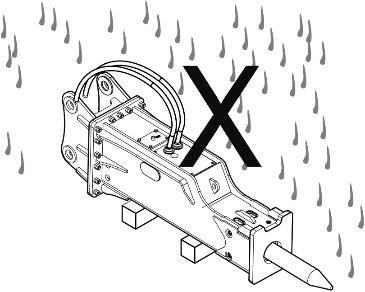
In case of long term storage, prevent breaker corrosion referring to following instructions. • The storage area must be dry. • The storage area temperature must not be lower than -20ºC (-4°F). • Remove tool and tool pins from the breaker. • Discharge nitrogen gas completely from back head. • Push piston up to maximum position, using steel bar and hammer as illustrated below. • Apply grease on tool shank (or grooves), tool pins and bush inner surface. • Reassemble tool and tool pins to the breaker. • Prevent oil leakage and contamination by keeping all hoses, ports and holes sealed with clean plugs. • Keep the breaker covered with appropriate material like plastic or vinyl packing, tied with band, stored indoor as much as possible. • Store the breaker in horizontal position.
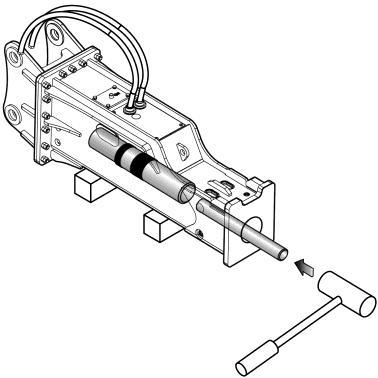
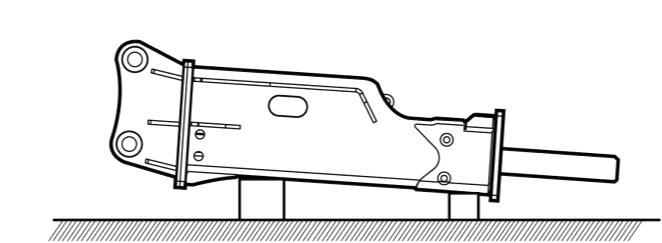
NOTE! If piston has not been pushed to maximum position, piston bottom area will be exposed to the air and have a high probability to be rust. In case the breaker is stored in a vertical position, piston will gradually drop down by gravity and be exposed to the risk of corrosion.
t) Operating breaker after long term storage
In case of the breaker has been stored for more than 2 years, seals must be replaced with brand new ones prior to start of breaker operation.
NOTE! No replacement of seals will void warranty of the breaker manufacturer.
u) Travelling position
The travelling positions are shown below. Ensure that the breaker is not too close to carrier backhoe boom/arm, when travelling with tracked loader backhoe (or backhoe loader).
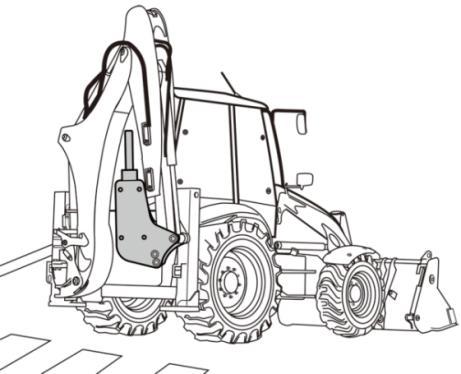
Breaker in travelling position
NOTE!
Breaker positioning between boom and arm (illustrated on the left picture) is achieved, depending on carrier model & boom/arm specification.
When travelling with skid steer loader, lower carrier boom and tilt the breaker fully backwards.
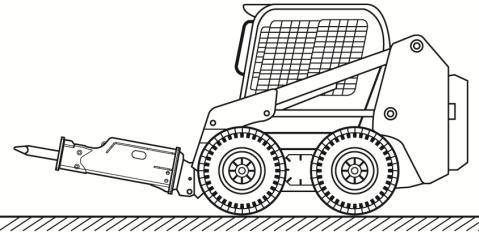
Breaker in travelling position
When travelling with excavator, ensure the breaker not to be too close to the cabin.
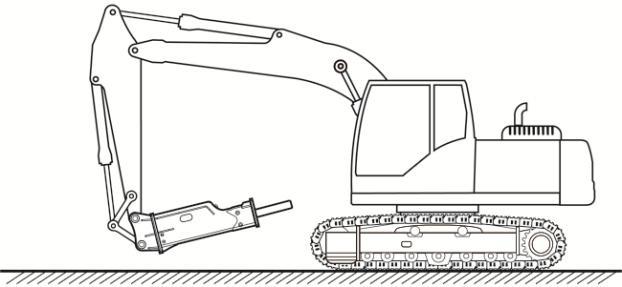
Breaker in travelling position









